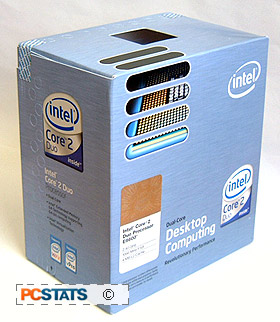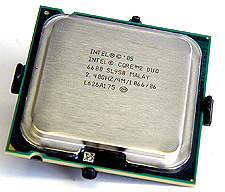The Intel Core 2 Duo and Socket 775 Pentium 4/D and Celeron processors are
physically identical, but what's under the hood that is special! The Core 2 Duo series
targets the higher end segment of the computer industry while the Pentium 4/D and
Celeron go after mainstream and entry level markets.

Components on CPU are fragile, use caution when handling
processor!
Intel plans
to transition its Celeron line over to the Core 2 Duo architecture
(the Celeron L), but we're still waiting for that to happen. The Core 2 Duo family
lineup are as follows. Note the operating frequency and L2 Cache size
differences and keep in mind that the Core 2 Quad Q6600 and Core
2 Extreme QX6700 have four processing cores, that's why there is 8MB of
L2 cache.
| Intel Socket 775 Core 2 Duo
Processors |
|
Processor
Models |
Thermal Design
Power |
Clock
Speed |
L2 Cache Size |
Price |
| Intel Pentium D
960 |
130W |
3.6 GHz |
4MB |
$344 |
| Intel Pentium D
940 |
95W |
3.2 GHz |
4MB |
$175 |
| Intel Pentium D
840 |
130W |
3.2 GHz |
2MB |
$163 |
| Intel Core 2
Extreme X6800 |
75W |
2.93
GHz |
4MB |
$962 |
| Intel Core 2 Extreme QX6700 |
130W |
2.66 GHz |
8MB |
$977 |
| Intel Core 2 Duo
E6700 |
65W |
2.66
GHz |
4MB |
$532 |
| Intel Core 2 Quad Q6600
|
105W |
2.4 GHz |
8MB |
$834 |
 Intel Core 2 Duo E6600 Intel Core 2 Duo E6600 |
65W |
2.4 GHz |
4MB |
$313 |
| Intel Core 2 Duo
E6400 |
65W |
2.13
GHz |
2MB |
$229 |
| Intel Core 2 Duo E6300 |
65W |
1.86 GHz |
2MB |
$194 |
| Intel Core 2 Duo
E4300 |
65W |
1.8 GHz |
2MB |
$169 | |
Of the bunch, the Intel Core 2 Duo
E6600 is easily the most appealing. It runs at a nice 2.4 GHz clock
speed, comes with 4MB of L2 cache and is moderately priced at $313USD. The Thermal Design Power is
65W, where as a high end Core 2 Extreme X6800 has a TDP of 75W.
Intel's TDP figures
are not compatible with AMD's power numbers, because Intel measures average power draw while AMD lists
maximum. PCSTATS will give you a clear idea of how much power the Core 2 Duo E6600
processor draws in our upcoming power draw tests. For comparisons sake, it's obvious that
the Core 2 Duo chews up less power than the older Pentium D series, in fact the
E6600 is rated to use half the power of the Pentium D 840 or 960!
Power requirements should go down further as Intel refines its
manufacturing process and as dies shrink from 65nm to 45nm. With the Intel Core
2 Duo line using 65W of energy, that heat output is pretty tame for a cutting
edge chip. In fact many Core 2 Duo motherboards have options to turn off the fan
completely during idle periods!
Technologies behind the Intel Core 2 Duo
processor
 Built on Intel's 65 nanometer
manufacturing process, the Core 2 Duo E6600 processor has 291 million
transistors which take up 143mm2 of
die space. The chip comes in a Socket 775 form factor and runs with DDR2-800 memory.
Built on Intel's 65 nanometer
manufacturing process, the Core 2 Duo E6600 processor has 291 million
transistors which take up 143mm2 of
die space. The chip comes in a Socket 775 form factor and runs with DDR2-800 memory.
There are
several innovative technologies integrated into the Intel Core 2 Duo E6600
processor, including SSE/2/3, Intel x32-64, the Execute Disable Bit,
Virtualization Technology (VT) and Intel's Enhanced Speed Step Technology.
PCSTATS has already covered SSE/2/3 technology, Intel x32-64 and the Execute
Disable Bit in previous CPU reviews so we will focus on VT and EIST this time
around.
Virtualization Technology Explained:
Running
virtual operating systems on one computer system is gaining popularity,
but ask anyone who's done it and you'll no doubt hear about compatibility, performance
and stability issues. Intel has identified this and has integrated
VT or Virtualization Technology into its mainstream processor to make virtualization
run smoother. Code named 'Vanderpool', VT allows the processor to act as
several CPUs working in parallel on the same machine.
 Traditionally, virtual operating systems do not have complete access to
the computer hardware and must rely on the Virtualization Machine Monitor (aka VMM). The
VMM emulates a complete set of hardware for each virtualized OS. Access to
the hardware components is separated into different "Ring" levels, depending on
the type and access of software. For instance Operating Systems like WindowsXP
are given Ring 0 access which means it gets all the CPU resources. Programs
like Microsoft Word running on top of the OS are allocated to Ring levels
1 or 3, restricting the software's ability access hardware for stability
reasons.
Traditionally, virtual operating systems do not have complete access to
the computer hardware and must rely on the Virtualization Machine Monitor (aka VMM). The
VMM emulates a complete set of hardware for each virtualized OS. Access to
the hardware components is separated into different "Ring" levels, depending on
the type and access of software. For instance Operating Systems like WindowsXP
are given Ring 0 access which means it gets all the CPU resources. Programs
like Microsoft Word running on top of the OS are allocated to Ring levels
1 or 3, restricting the software's ability access hardware for stability
reasons.
Intel Virtualization Technology adds a new
execution mode called VMX Root Operation (Virtual Machine eXtensions) where the
VMM runs. This allows the virtualized OS's to run at Ring 0 natively and
support software at Ring 1 or 3.
By giving
software native ring support, it allows VMM's to be smaller, less complex and
efficient which improves compatibility and performance of virtualized OS's. It's important
that the Virtual Machine software you are running support these hardware
features. If it doesn't, you won't be able to take advantage of
this technology.
EIST-the new approach to desktop power savings
Enhanced
Intel SpeedStep Technology originates from the notebook platform, EIST cuts unnecessary power usage
and likewise heat output when the computer is idle or under light
loads. In order to enable EIST, you must have a compatible processor, motherboard, BIOS and
operating system. The Intel Core 2 Duo E6600, WindowsXP and Windows
Vista all support EIST.
 EIST is
very similar to AMD's Cool 'n' Quiet although it's name is not as cool. Essentially at
lower CPU usage, the motherboard will automatically decreases the CPU multiplier and CPU voltage, thereby
the processor will run slower and use less energy. In the
case of Intel's Core 2 Duo series, under light load the processor multiplier will
be lowered to 6x. When the motherboard detects higher CPU loads, the multiplier
will increase (in the Core 2 Duo E6600's case) to 9x.
EIST is
very similar to AMD's Cool 'n' Quiet although it's name is not as cool. Essentially at
lower CPU usage, the motherboard will automatically decreases the CPU multiplier and CPU voltage, thereby
the processor will run slower and use less energy. In the
case of Intel's Core 2 Duo series, under light load the processor multiplier will
be lowered to 6x. When the motherboard detects higher CPU loads, the multiplier
will increase (in the Core 2 Duo E6600's case) to 9x.
With the
popularity of distributed computing programs
like Folding @ Home or SETI @ Home, it's important to remember
that these applications keep CPU usage at 100% all the time. In this
case EIST will not be able to save power or lower heat output.
Next up PCSTATS will run total system power tests
to see how much power the E6600 draws in a standard system compared to several
other current CPUs...
